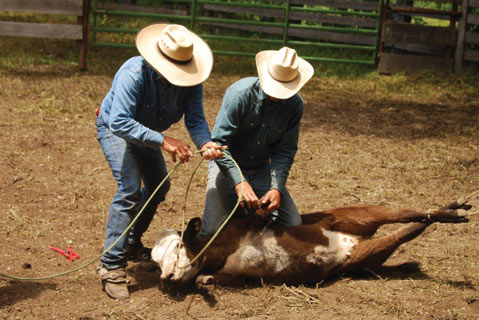How Green Was My Valley
Dry Days in Santa Ynez Valley

S.Y.V. DROUGHT: If you turn off Highway 101 onto Old Coast Highway, then head down narrow, winding Alisal Road, these days you’ll find dry fields where normally you’re greeted by the green hills of the Santa Ynez Valley. And as you drive north past the vast Alisal Ranch, through Solvang and farther north into the valley, signs of the deepening drought only get worse.

Cattle ranchers are hurting, some opting to sell off livestock rather than absorb the high cost of buying feed. Others are hanging in there.
But it’s nothing like the catastrophic drought of 1862-65 that killed off thousands of longhorns, destroyed Santa Barbara County’s cattle industry, impoverished the old Mexican land-grant families, and hastened the end of the “Days of the Dons.”
The overly romanticized “Old Spanish Days” saw the breakup of the immense land grants and a takeover by the influx of Yankees after California became a state.
Oddly, the drought was preceded by torrential rains in the winter of 1861-62, bringing disastrous floods that washed soil down from the mountains, depositing 14 feet of dirt on Goleta Valley, destroying crops and wiping out Goleta’s potential port.
It is said that one storm lasted over a month, flooding farmlands with more than 50 inches of rain.
Spring brought a rich growth of grass to fatten Santa Barbara County’s estimated herds of up to 250,000 head of beef on the hoof. Wealth of the ranchero families depended in large part on the prosperous hide and tallow trade.
But then Mother Nature reversed gears with three years of drought that left the land parched and the cattle thirsty. Life-giving creeks dried up. Cattle began dying off or were butchered. As desperate California ranchers thinned their herds, prices plummeted.
“Centuries-old oak trees were chopped down so the cattle could eat the leaves that were otherwise out of reach,” local historian Walker (“Two-Gun”) Tompkins wrote in It Happened in Old Santa Barbara.
“Great matanzas, or slaughters, were held at Miramar Beach, so as to salvage the cowhides and let the carcasses drift out to sea for the sharks and gulls to scavenge. The giant condors and buzzards of the back-country peaks waxed fat, feasting on carrion.
“By year’s end, 1864, only 5,000 cattle remained alive in Santa Barbara County; the remaining 245,000 had died of starvation and thirst, or had been butchered.” To make matters worse, a smallpox plague spread through the state.
Unable to pay their taxes, ranchers who had managed to prove ownership after the U.S. takeover of California lost their land.
By the time rains returned, California’s cattle industry was ruined. Herds were down by an average of 45 percent and by more than 70 percent in Los Angeles County, according to the L.A. Times.
“Waiting in the wings were opportunistic Yankee speculators, who swooped down on the impoverished cattle ranches up for taxes,” Tompkins wrote. “The entire Lompoc Valley, for example, some of the richest agricultural land in the world, went to the More Brothers of Ohio, for $1.25 an acre.” But they, in turn, soon lost the land.
“The vast Jesus Maria Rancho, now Vandenberg Air Force Base, was sold by its Mexican grantee for a silver saddle and two silk dresses for his womenfolk.”
Today, about 37,500 cattle roam the range in Santa Barbara County, according to the county Ag Commissioner’s office, and ranch families hold spring brandings I’ve been lucky enough to watch. Traditions have changed little over the past century. Cowhands rope wide-eyed young animals, holding them down as irons heat in wood fires, ready to sear brands into their hides.
It’s an age-old Western scene of bellowing cattle, smoke, smells, snorting horses, and sweating cowboys.
LAFF RIOT: What’s life without one of those English farces, complete with slamming doors, women wearing almost nothing, guys dropping their pants, and affairs galore? Last year, Circle Bar B Ranch Dinner Theatre staged the loony Noises Off to rave reviews. It was pretty zany, so I loved it. Now Ventura’s Rubicon Theatre is putting it on, January 29 - February 23, and Santa Barbara City College Theatre Group will also romp through it, March 7-22. I’ll see both versions, of course. Why not?
NEW VIC: Over at the splendid New Victoria Theatre, Ensemble Theatre forges ahead in its handsome new digs with Good People, a romantic-comic tale of two Boston neighborhoods (on the boards Feb. 6-23). Then there’s Murder at the Waterfront, a mystery served up at Chuck’s Waterfront Grill along with a three-course dinner. Craziness is promised (Wed., Jan. 22. $68. Call 564-1200).



